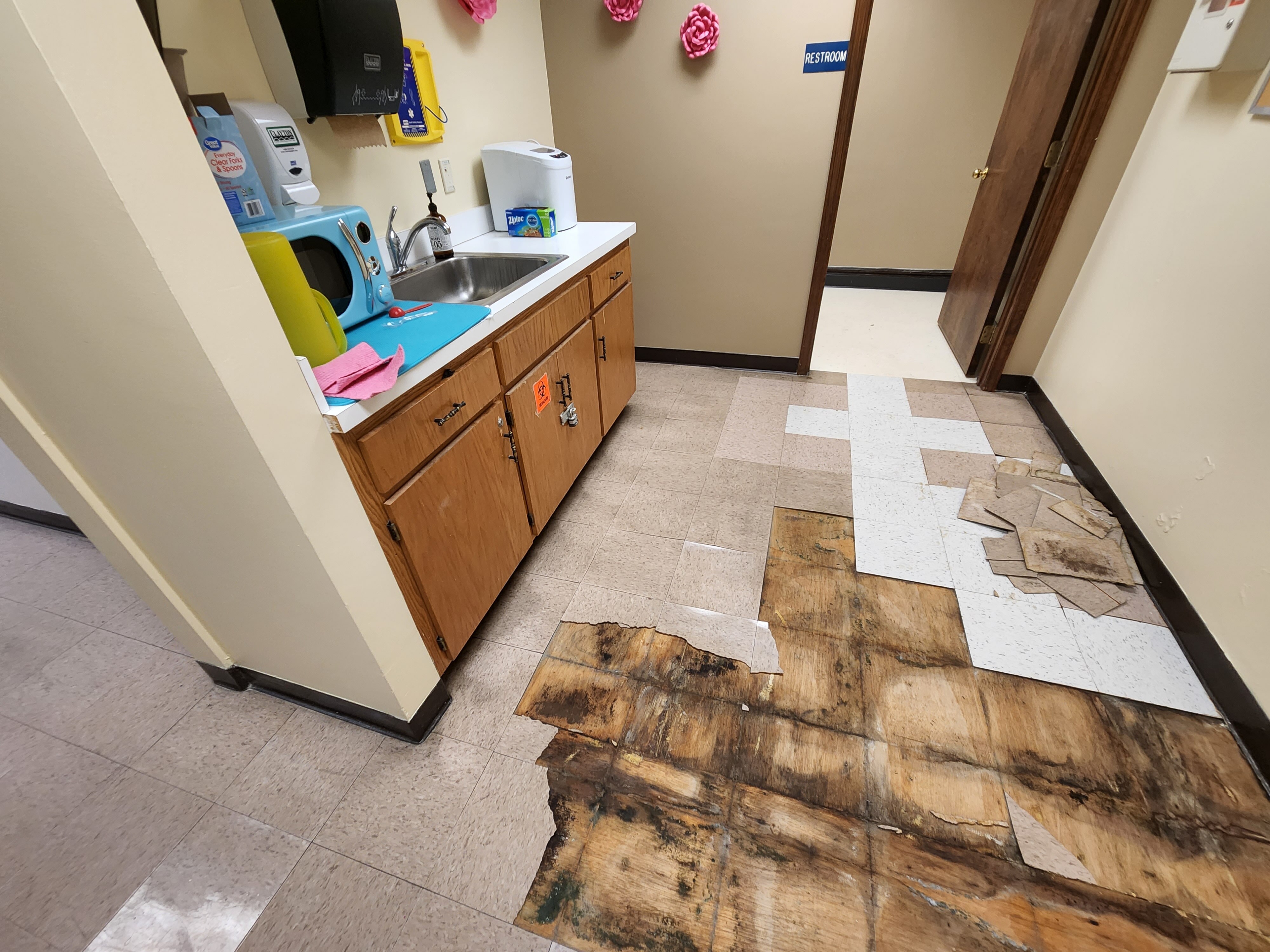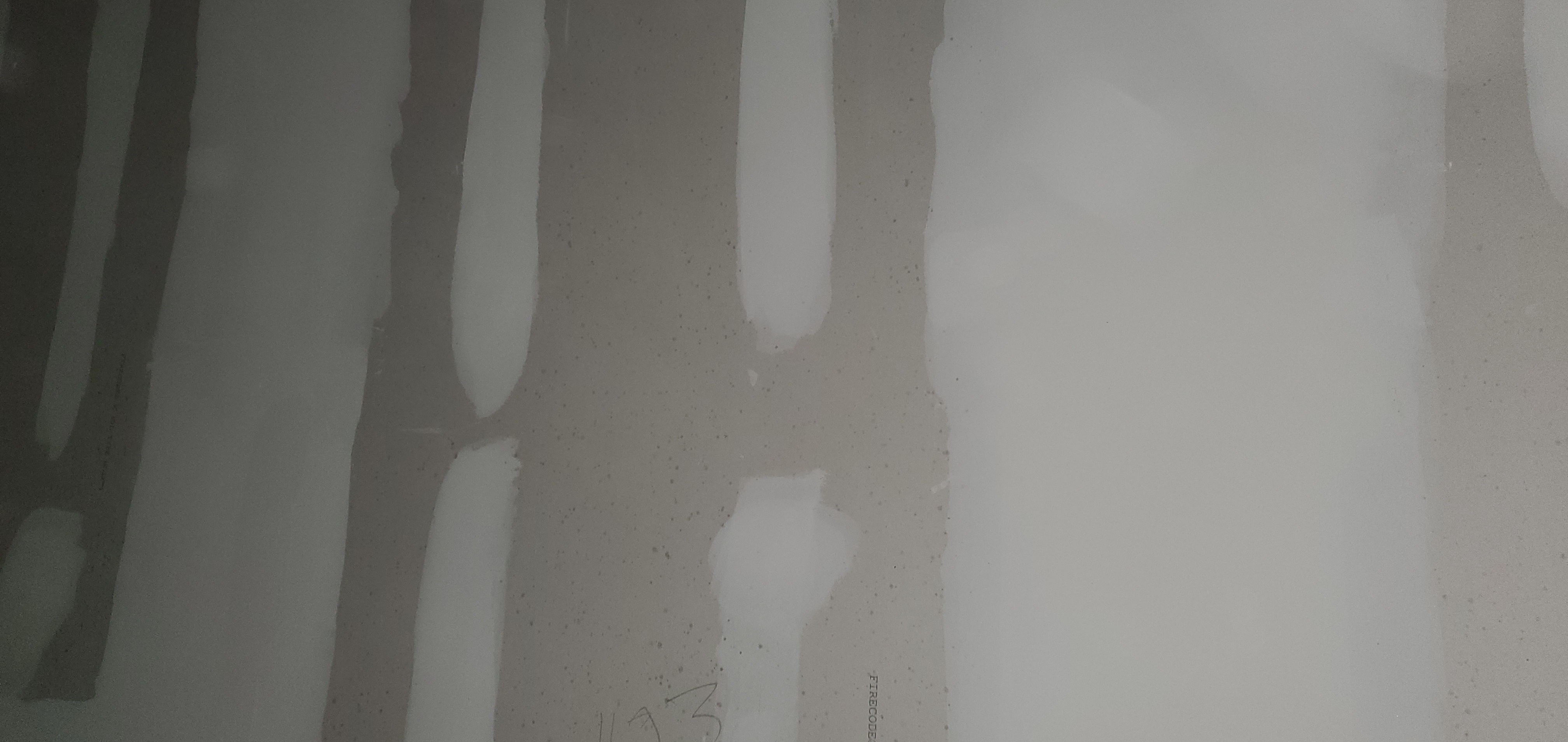Our Guide to Mold Signs, Symptoms, Remediation, and Water Damage Prevention in Offices
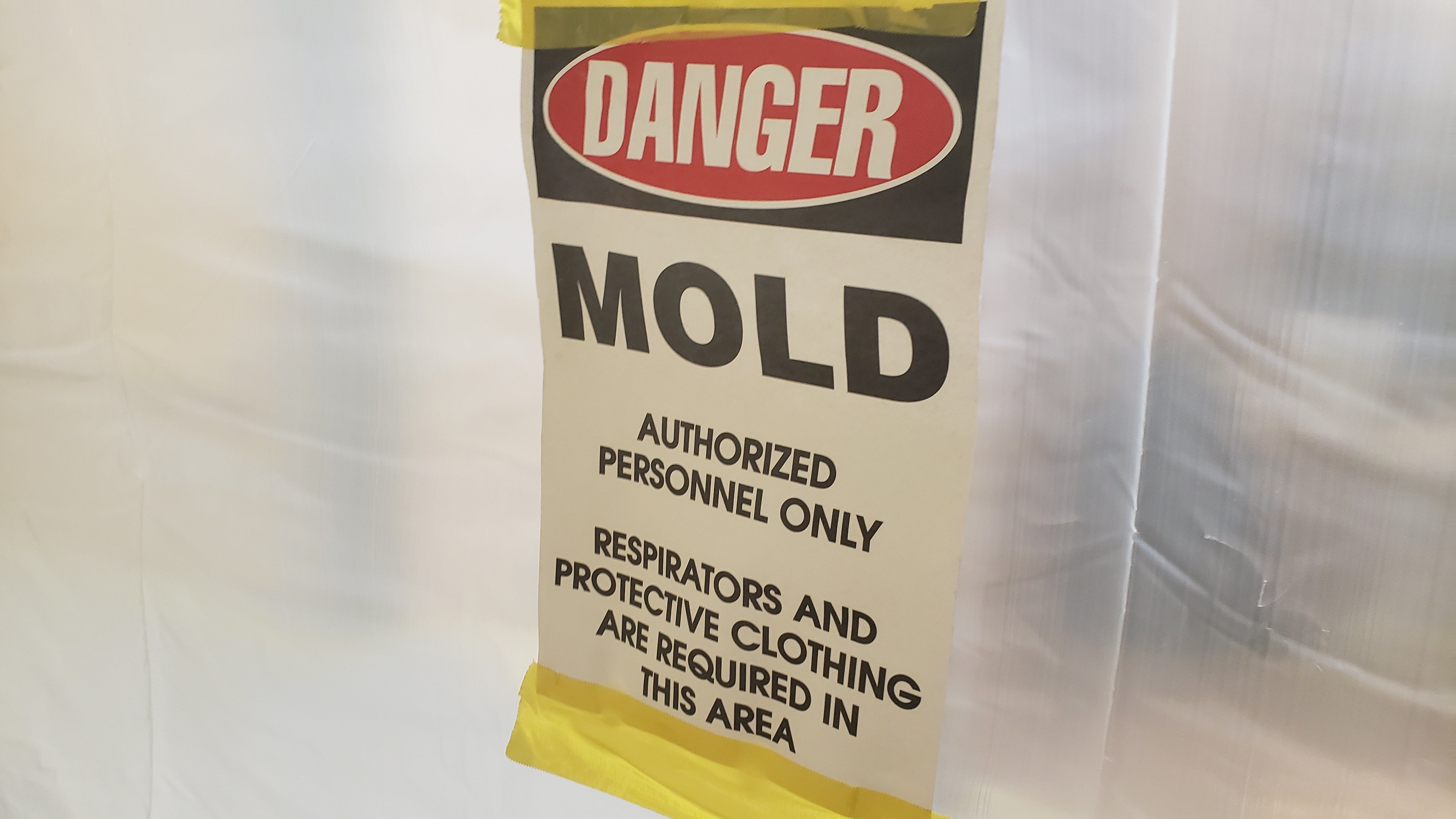
Mold is not just a nuisance; it can pose serious health risks and compromise the structural integrity of your workplace. In this guide, we'll dig into the telltale signs of mold, such as musty odors, suspect visible mold growth, and health symptoms like respiratory issues and allergies.
We'll also explore effective remediation techniques and proactive measures to prevent moisture damage, the leading cause of mold infestations.
What's Inside?
- Understanding Mold in Office Environments
- Sources of Mold Growth in Commercial Buildings
- Signs and Symptoms of Mold Presence
- Identifying Mold in Offices: Inspection and Testing
- Remediation and Removal of Mold
- OCCU-TEC’s Recommendations for Mold Remediation
- Commercial Water Remediation to Prevent Mold Growth
- How to Get Rid of Mold and Prevent Recurrence
- Partner with OCCU-TEC to Create a Safe Working Environment
Understanding Mold in Office Environments
What is mold? What does it look like?
Mold, a type of fungus, thrives in damp and humid environments, making offices particularly susceptible to its growth. It appears in various colors and textures, ranging from black, green, or white fuzzy patches to slimy coatings.
Many species of mold appear in large color variations, and color is not always indicative of a certain species. The only way to differentiate species is by sampling and lab analysis. Mold can often hide within walls, ceilings, carpets, and ventilation systems, making detection challenging without professional assistance.
Certain mold species are often a sign of a sustained moisture intrusion problem, including but not limited to Stachybotrys, Fusarium, Trichoderma, Memnoniella, and Chaetomium. These species are typically not found indoors without a moisture intrusion event.
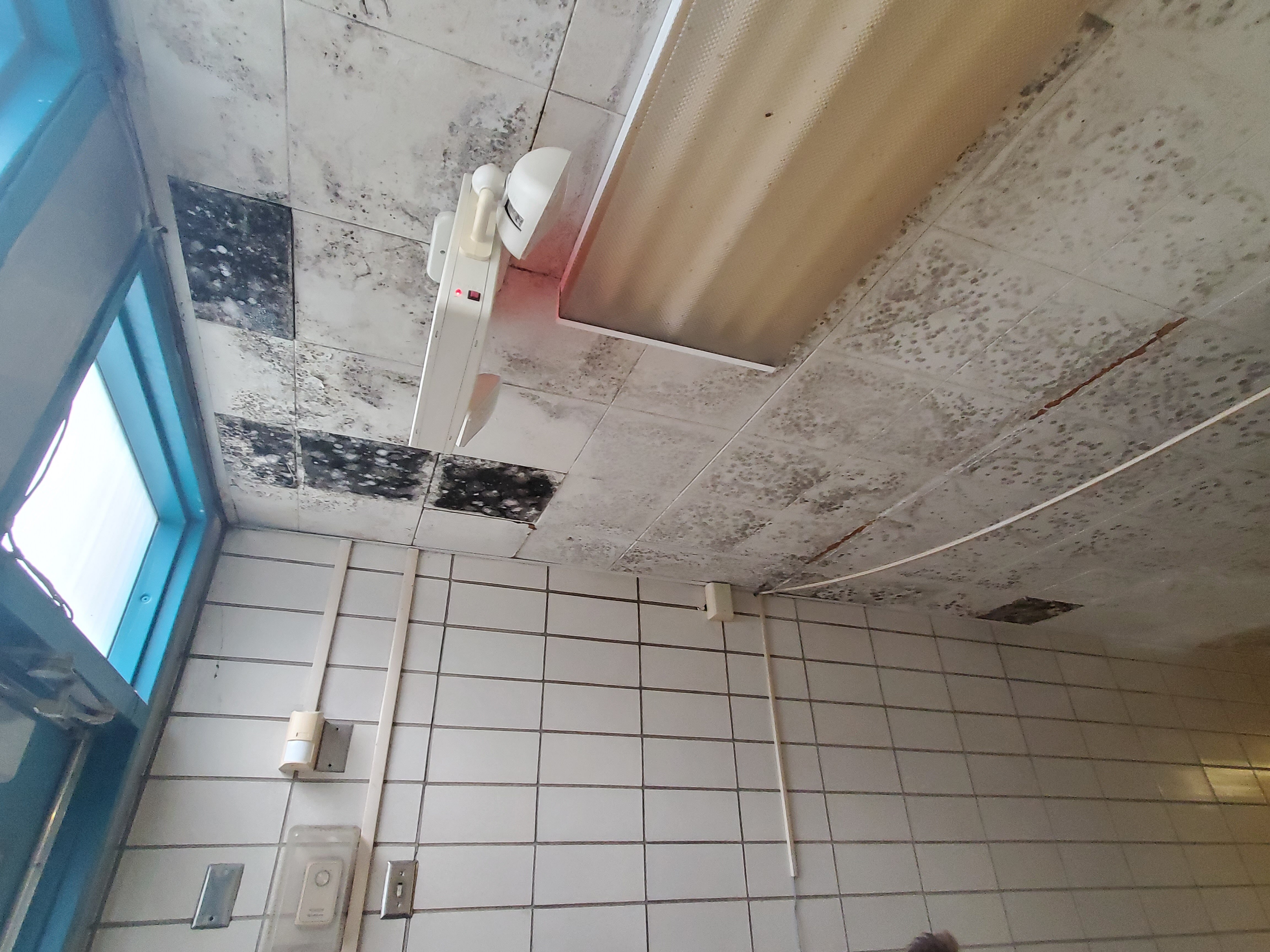
|
Mold growth under floor tiles |
|
Light mold growth on drywall |
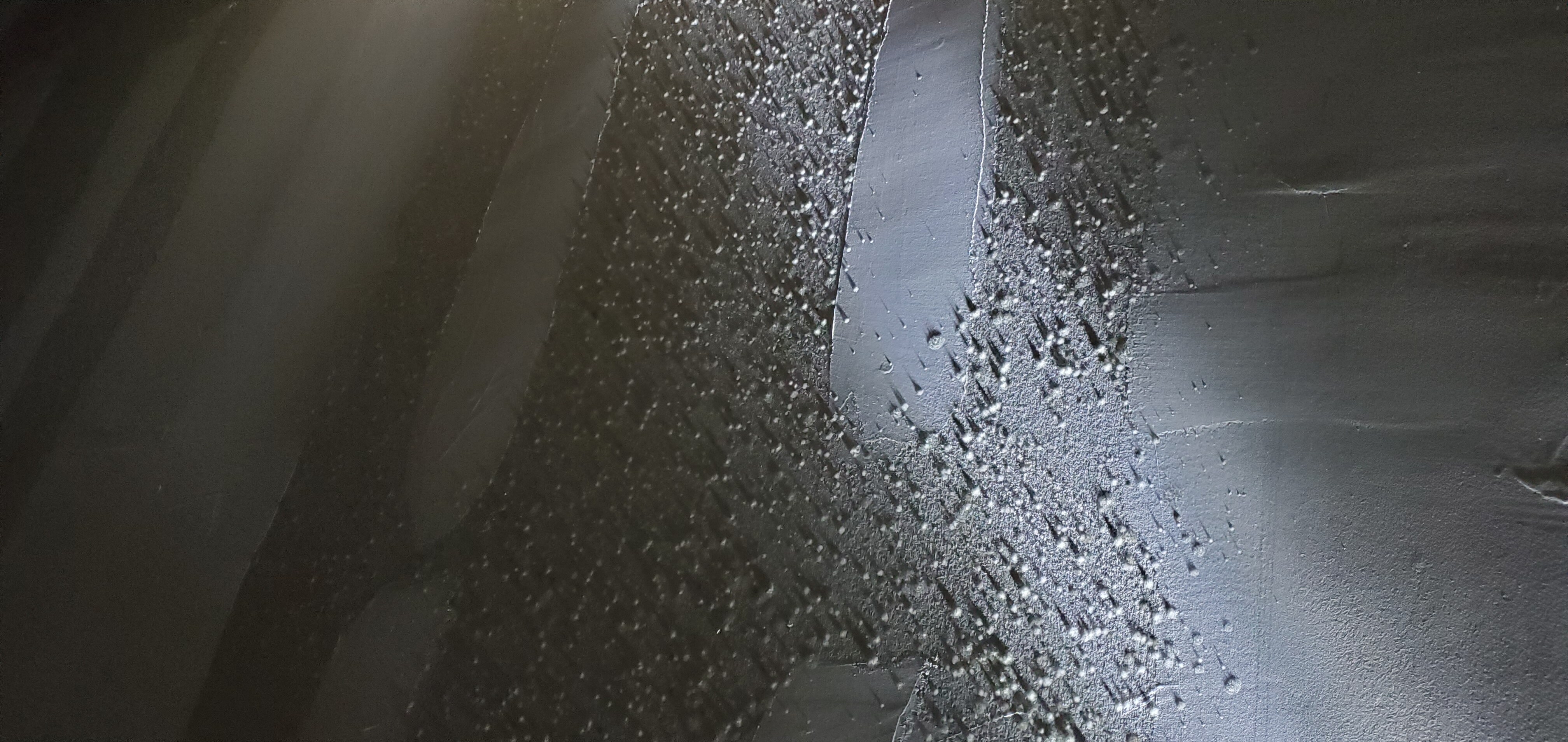
|
Sources of Mold Growth in Commercial Buildings
Mold finds its way into office spaces through various sources, including water leaks, flooding, high humidity levels, and poor ventilation. Common culprits include leaky pipes, roof leaks, condensation buildup, and inadequate drainage systems.
In addition, frozen pipes, clogged drain lines, HVAC system condensation, failing drip pans, and improper exterior landscaping can lead to mold issues. Even minor water intrusions, if left unaddressed, can create favorable conditions for mold growth, leading to costly damage and health concerns.
Sources of Mold in Commercial Buildings |
|
|
Flooding |
Poor ventilation |
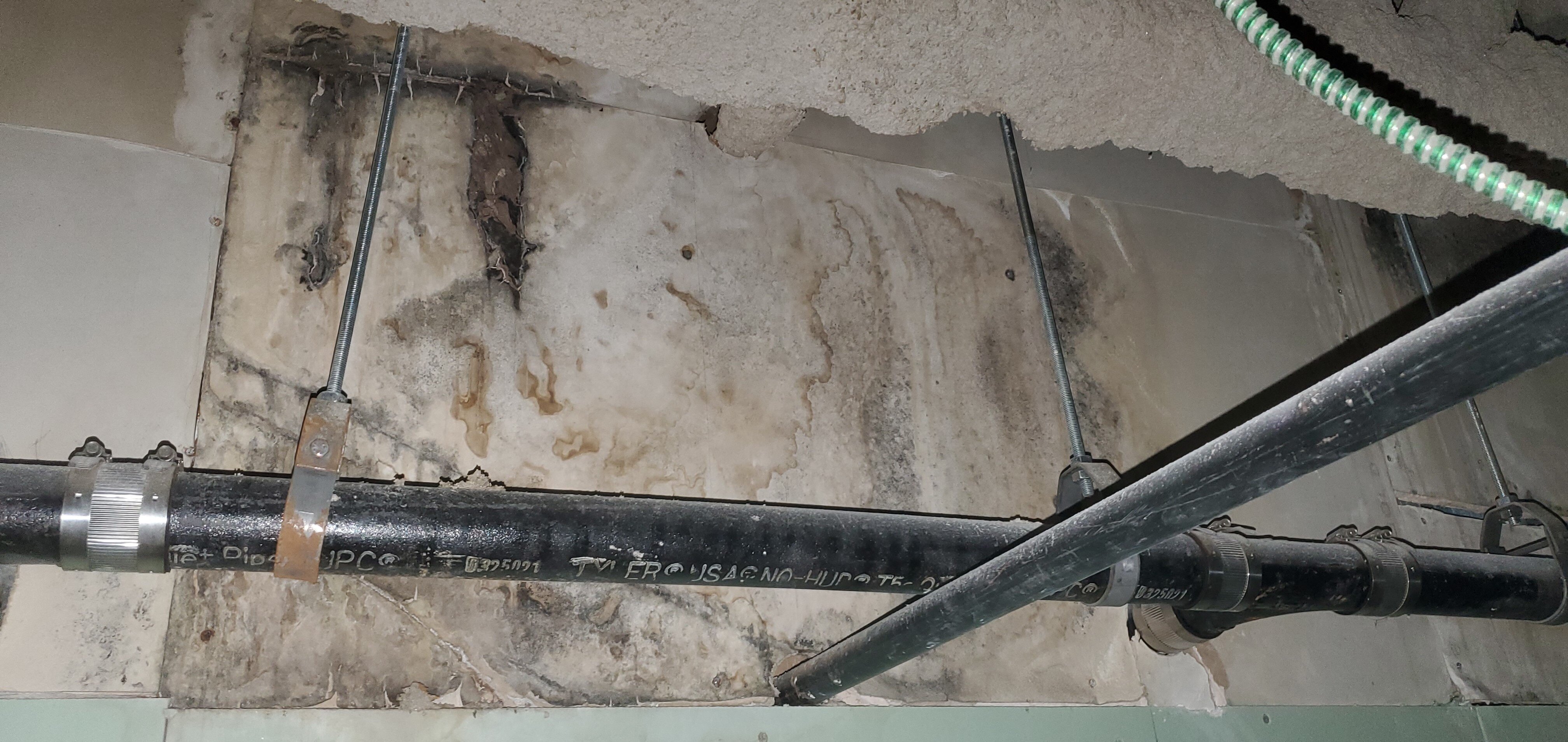
|
|
The Impact of Mold on Indoor Air Quality and Employee Health
The presence of indoor mold spore amplification in office environments compromises indoor air quality and can potentially pose serious health risks to employees according to an OSHA guide. Mold spores can become airborne and circulate through HVAC systems, triggering respiratory issues, allergies, and asthma attacks.
Prolonged exposure to mold can exacerbate existing health conditions and cause new ones, resulting in absenteeism, reduced productivity, and increased healthcare costs for businesses. Addressing mold promptly is crucial to maintaining a healthy and safe workplace for everyone.
Signs and Symptoms of Mold Presence
Physical Symptoms Employees Might Experience
 Mold exposure can manifest in various physical symptoms among employees, ranging from mild irritations to severe health issues. Common allergic symptoms include sneezing, coughing, skin rashes, and respiratory issues like congestion, wheezing, and shortness of breath.
Mold exposure can manifest in various physical symptoms among employees, ranging from mild irritations to severe health issues. Common allergic symptoms include sneezing, coughing, skin rashes, and respiratory issues like congestion, wheezing, and shortness of breath.
Individuals with existing respiratory conditions, such as asthma, may experience exacerbated symptoms in environments with mold contamination.
Visual Signs of Mold Growth
 Visual cues are often the first indicators of mold presence in office spaces. Keep an eye out for discoloration on walls, ceilings, and surfaces, which may appear as black, green, or brown patches.
Visual cues are often the first indicators of mold presence in office spaces. Keep an eye out for discoloration on walls, ceilings, and surfaces, which may appear as black, green, or brown patches.
Additionally, a musty odor, reminiscent of dampness or mildew, may permeate the air, especially in areas prone to moisture buildup. Ignoring these visual and olfactory cues can lead to widespread mold infestation and potential health hazards for occupants.
Behavioral Indicators of Air Quality Issues
 Changes in employee behavior and well-being can serve as indirect indicators of air quality issues related to mold contamination. An increase in sick days taken by staff members may signal poor indoor air quality and potential mold-related health concerns.
Changes in employee behavior and well-being can serve as indirect indicators of air quality issues related to mold contamination. An increase in sick days taken by staff members may signal poor indoor air quality and potential mold-related health concerns.
Additionally, complaints of discomfort such as headaches, fatigue, and difficulty concentrating may arise in environments with elevated mold spore concentrations. Monitoring employee health and addressing any signs of mold promptly are essential for maintaining a conducive work environment.
Identifying Mold in Offices: Inspection and Testing
When to Have a Professional Inspect Your Building for Mold
It's crucial to enlist the expertise of a professional mold inspector when signs of mold presence are observed or suspected in office spaces. This includes instances of suspect visible mold growth, musty odors, moisture damage, or unexplained health symptoms among employees.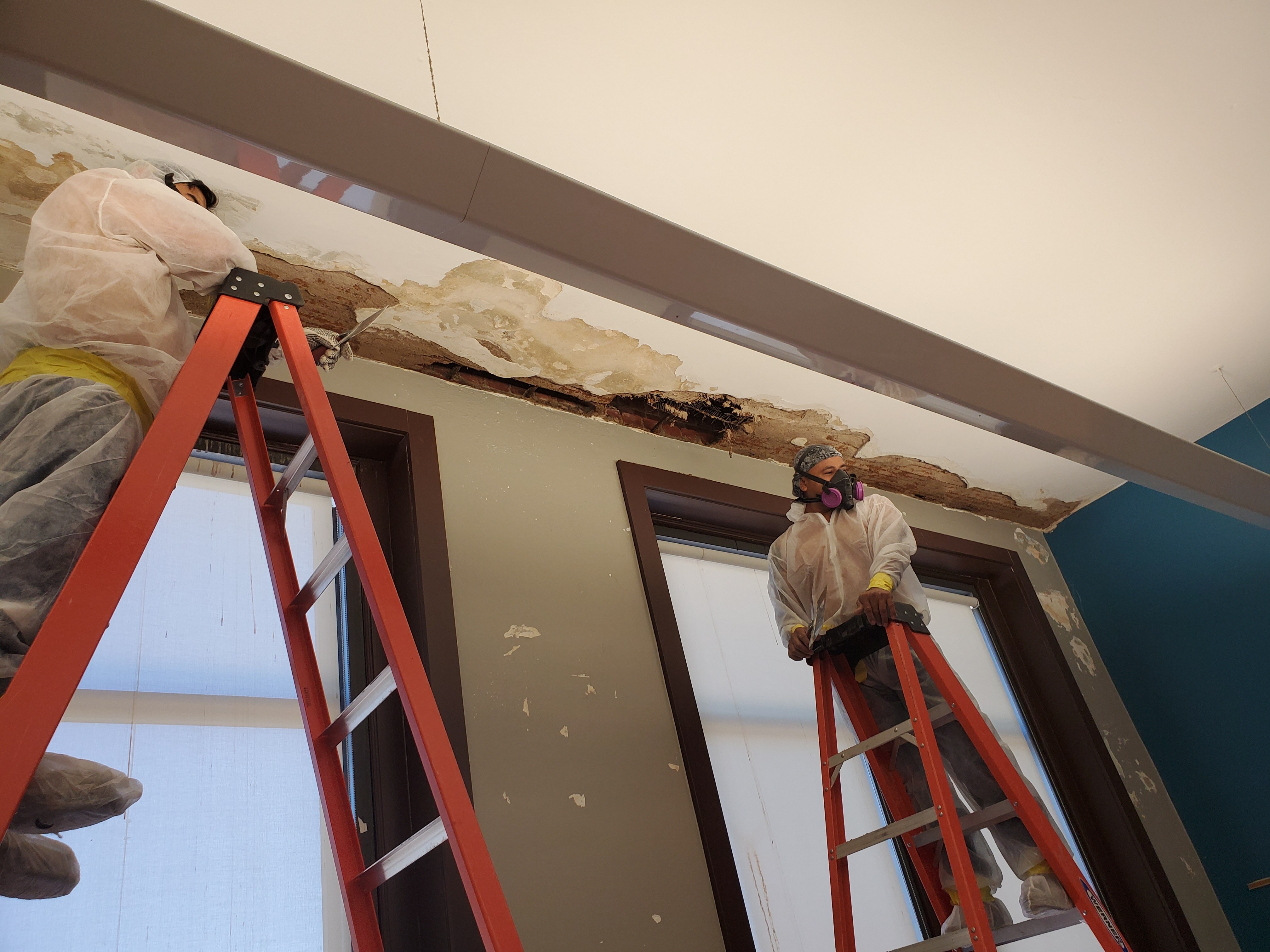
A thorough inspection by OCCU-TEC's qualified professionals can pinpoint the extent of mold contamination and identify underlying causes such as water leaks or inadequate ventilation systems.
“We provide indoor environmental quality assessments, which are more than just a typical indoor air quality assessment,” said Justin Arnold, project manager and Council-certified Indoor Environmental Consultant (CIEC) for OCCU-TEC.
“We’re looking at all things that can potentially affect a person’s health, which can be lighting, temperature differential, relative humidity levels, CO, CO2, total volatile organic compounds (TVOC), formaldehyde, basically anything that impacts health or the perception of health.”

Justin Arnold, project manager and Council-certified Indoor Environmental Consultant (CIEC) for OCCU-TEC
Methods and Technologies Used for Mold Testing in Office Environments
Professional mold testing in office environments typically involves a combination of visual inspections, air sampling, and surface sampling to assess mold levels accurately. Air sampling captures airborne mold spores using specialized equipment, while surface sampling collects mold particles from various surfaces for analysis.
Advanced technologies such as infrared cameras and moisture meters may also be employed to detect hidden mold growth and moisture sources within building structures.
“A lot of the time, clients want a simple air sample. However, air samples are just one tool we use during an inspection and the physical/visual inspection is just as, if not more, important than air samples. We will take samples from both the interior and exterior and we’ll compare the two samples,” Arnold said. “Beyond that, we use many different tools to take readings, send out samples collected to be tested, and then report to the client what we found.”
OCCU-TEC utilizes a FLIR MR77 for assessing moisture levels present at the Site. The FLIR can be used to detect and measure moisture in non-conductive solid materials such as wood, drywall, and masonry.
OCCU-TEC utilizes a GrayWolf AdvancedSense® Pro Environmental Test Meter for measuring temperature, relative humidity, and concentrations of carbon monoxide (CO), carbon dioxide (CO2), formaldehyde, and total volatile organic compounds (TVOCs) in real time.
Airborne particulates are measured with a GrayWolf PC-3500 Handheld Particulate Meter. The GrayWolf PC-3500 Particle Counter, measures 0.3 micrometer (μm) to 25.0 μm with a flow rate of 0.1 CFM (2.83 LPM).
OCCU-TEC utilizes a FLIR C2 thermal camera to conduct a thermal inspection of the subject area. The thermal camera highlights temperature differentials in the subject areas. Temperature differentials do not indicate moisture but can be a resourceful tool for finding possible areas of concern.
Interpreting Mold Test Results and Understanding Mold Levels
Interpreting mold test results requires expertise to distinguish between normal background levels of mold spores and elevated concentrations indicative of a mold problem. Professional mold inspectors can analyze test results and provide detailed reports outlining the type and quantity of mold present, as well as recommendations for remediation and prevention measures.
Understanding mold levels and their implications is essential for devising effective strategies to mitigate mold growth and maintain a healthy indoor environment for occupants.
Remediation and Removal of Mold
Hiring Professional Mold Remediation Services
If OCCU-TEC has identified mold in your office environment, the next crucial step is its removal. Handling mold infestations, particularly in office settings, necessitates the expertise of professional mold remediation services.
These specialists are adept at assessing, containing, and safely removing mold, ensuring thorough remediation and preventing its recurrence. Utilizing industry-standard practices and adhering to strict safety protocols, professional remediation services mitigate health risks associated with mold exposure effectively.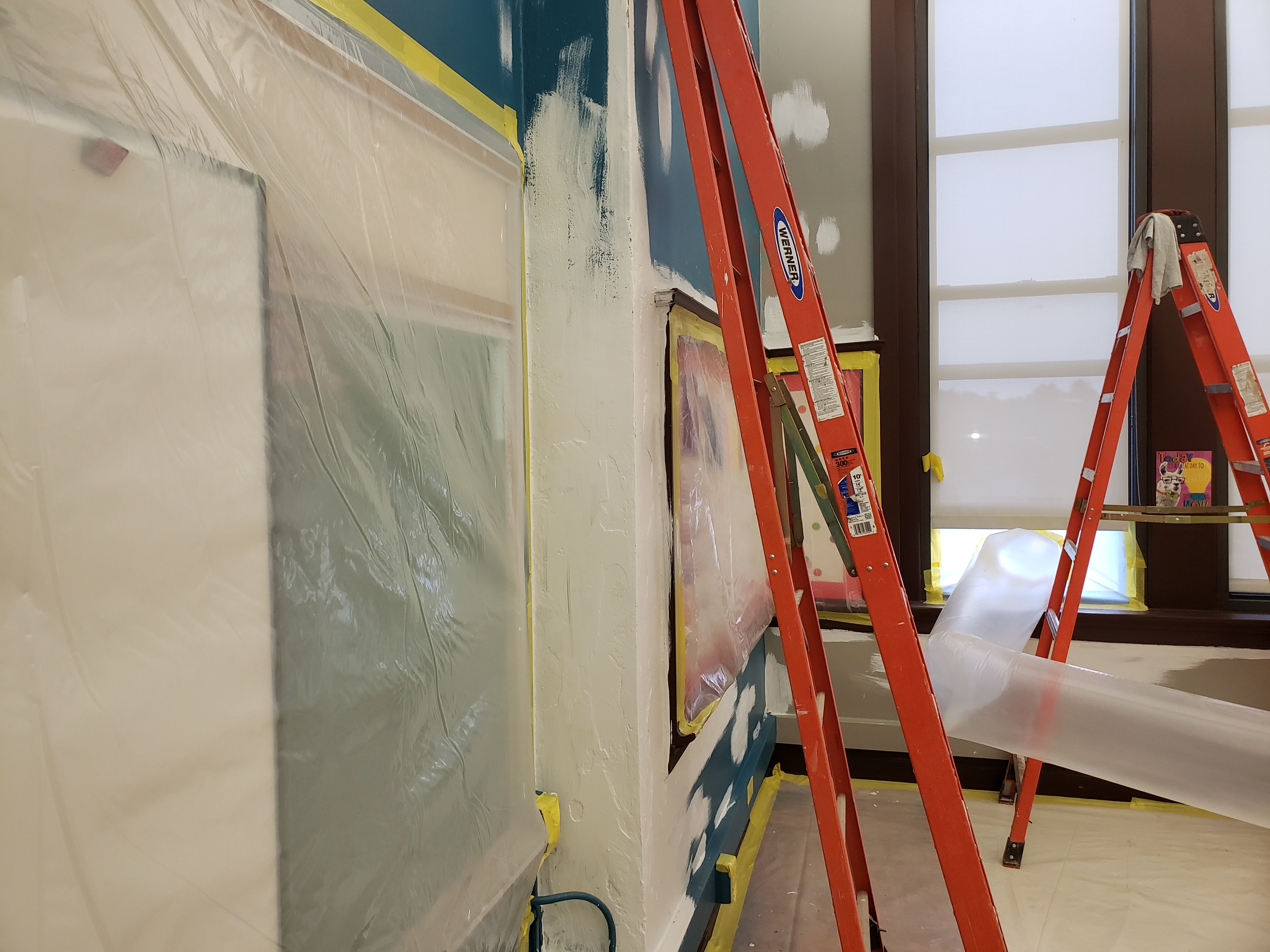
Mold is just a symptom of a larger problem and not necessarily the source of the issue. If only the symptom is treated, the mold will return. Moisture intrusion issues or those issues causing the environment to be more suitable for mold growth need to be remediated to prevent mold recurrence.
When dealing with mold infestations in office environments, it's imperative to enlist the expertise of professional mold remediation services. These specialists are trained to assess, contain, and safely remove mold, ensuring thorough remediation and preventing its recurrence.
Professional remediation services employ industry-standard practices and adhere to safety protocols to mitigate health risks associated with mold exposure.
Steps Involved in Mold Removal Process
The mold removal process encompasses several critical steps to ensure the complete elimination of mold contamination from office spaces: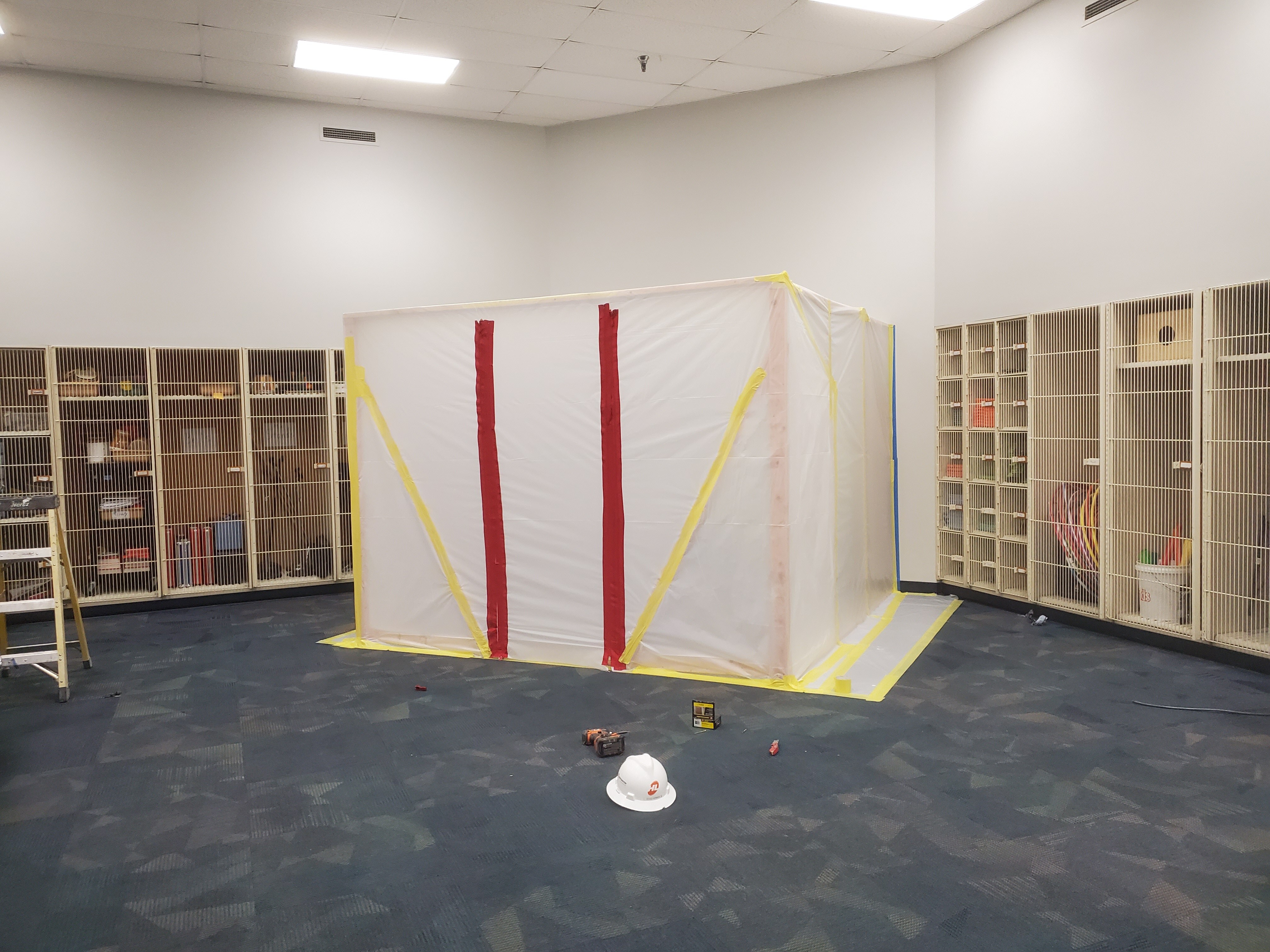
Mini mold containment solution
- Containment: Initial containment measures are essential to prevent the spread of mold spores to unaffected areas.
- Removal: This step involves the removal of mold-infested materials and surfaces.
- Cleaning and Disinfection: Thorough cleaning and disinfection of the affected areas follow.
- Specialized Equipment Use: Employing equipment such as HEPA filters and negative air machines to capture and filter airborne mold spores during remediation.
Importance of Addressing Underlying Causes of Mold Growth
Simply removing visible mold is not sufficient to prevent its recurrence. Addressing the underlying causes of mold growth, such as water leaks, excess humidity, or inadequate ventilation, is crucial.
Professional remediation services not only remove existing mold but also identify and rectify moisture sources and ventilation issues. This proactive approach helps maintain a mold-free and healthy workplace, safeguarding the well-being of employees and visitors.
OCCU-TEC’s Recommendations for Mold Remediation
OCCU-TEC provides detailed recommendations for mold remediation to ensure thorough and effective mold removal: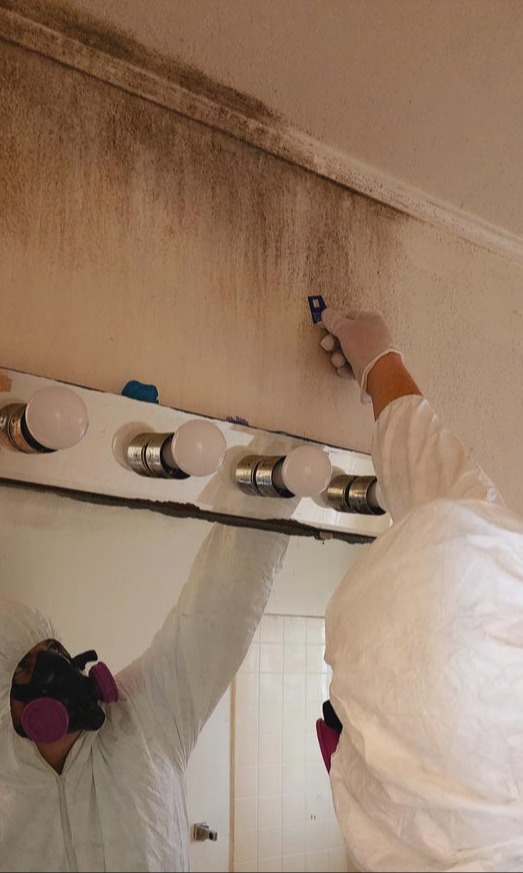
- Qualified Contractor: Mold remediation and cleaning should be performed by a qualified mold remediation contractor before any renovation activities.
- EPA Guidelines: All mold remediation activities should adhere to the guidelines established by the U.S. Environmental Protection Agency (EPA) in the "Mold Remediation in Schools and Commercial Buildings."
- Containment and Filtration: Work should be performed within appropriately sized containment, utilizing High Efficiency Particulate Air (HEPA) filtration devices.
- HVAC Isolation: Isolation of work areas from heating, ventilation, and air conditioning systems is recommended.
- Drywall Removal: Drywall removal should extend approximately 2 feet beyond the last visible evidence of mold growth or moisture damage.
- Surface Cleaning: Walls and surfaces should be cleaned with an EPA-registered fungicide, such as Fiberlock, Shockwave, or Foster First Defense. Post-cleaning, wall cavities should be encapsulated with a mold-resistant encapsulant, and the work area should be ‘fogged’ with an EPA-registered fungicide.
- Post-Remediation Evaluation: Conduct a Post-Remediation Evaluation, including a visual inspection as part of the Post-Remediation Verification (PRV) process. Any deficiencies noted should be addressed with additional cleaning until corrected. The PRV should be completed before reconstruction begins.
- Sampling: Upon completion of the PRV visual inspection, air samples and/or tape lift samples should be collected. The mold remediation is deemed complete when all work area samples meet the PRV criteria.

HEPA negative air machine exhausting outside
Commercial Water Remediation to Prevent Mold Growth
Common Sources of Water Damage in Office Buildings
Office buildings are susceptible to various sources of moisture damage, which can contribute to mold growth if left unaddressed. Common culprits include plumbing leaks, roof leaks, burst pipes, improper landscaping, and flooding from heavy rainfall or malfunctioning sprinkler systems.
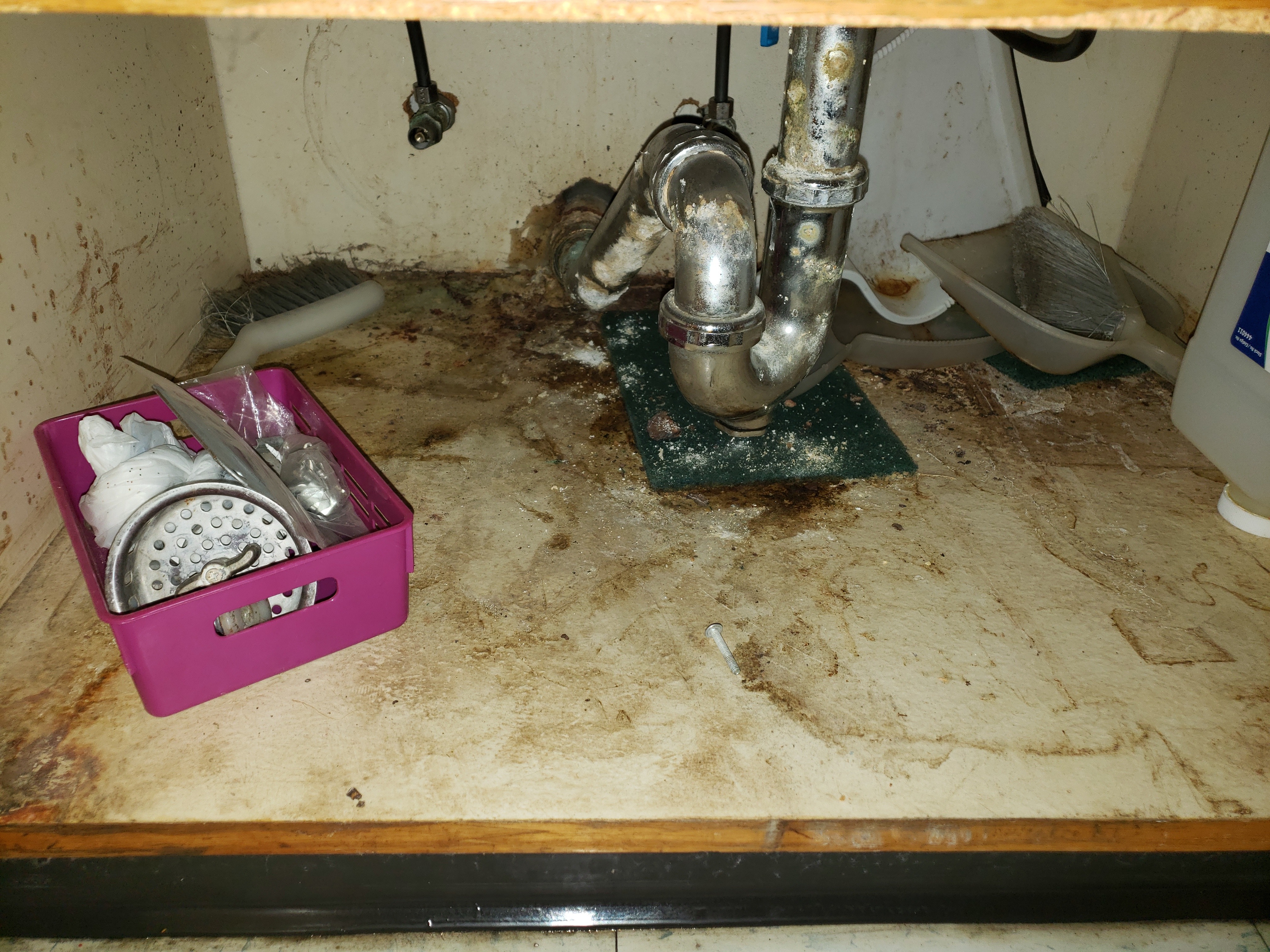 Strategies for Water Damage Prevention and Early Detection
Strategies for Water Damage Prevention and Early Detection
Implementing proactive measures to prevent moisture damage is essential for mitigating the risk of mold growth in office environments. Regular inspection and maintenance of plumbing systems, roofs, and building envelopes can help identify and address potential water intrusion points before they escalate into significant issues.
Installing moisture detection sensors and leak detection systems can provide early warning signs of water leaks, allowing for prompt intervention and mitigation efforts. Additionally, maintaining optimal indoor humidity levels and ensuring proper ventilation can help prevent moisture buildup and mold proliferation.
By prioritizing water damage prevention and early detection measures, businesses can safeguard their premises against mold contamination and maintain a healthy indoor environment for occupants.
How to Get Rid of Mold and Prevent Recurrence
Implementing Proper Ventilation and Moisture Control Measures
Proper ventilation and moisture control are essential elements in preventing mold growth and ensuring a healthy indoor environment in office spaces. Adequate ventilation helps to regulate humidity levels, reducing the risk of moisture buildup that can foster mold growth.
Installing exhaust fans in areas prone to high humidity, such as bathrooms and kitchens, promotes air circulation and moisture removal. Additionally, utilizing dehumidifiers can effectively reduce excess moisture in the air, creating an inhospitable environment for mold growth.
Implementing these measures helps to maintain optimal indoor air quality and mitigate the risk of mold infestations.
Regular Inspection and Maintenance of HVAC Systems and Building Envelope
Regular inspection and maintenance of HVAC (heating, ventilation, and air conditioning) systems are crucial for preventing mold growth and ensuring efficient moisture control in office buildings. Inspecting air ducts, filters, and condensate pans for signs of moisture accumulation or mold growth helps to identify potential issues before they escalate.
Cleaning and servicing HVAC components regularly improves system performance and reduces the risk of distributing mold spores throughout the building. Additionally, maintaining the integrity of the building envelope through routine inspections and repairs prevents water intrusion from exterior sources, further minimizing the risk of mold infestations.
By prioritizing proactive measures such as proper ventilation, moisture control, and regular maintenance of HVAC systems and the building envelope, businesses can effectively prevent indoor mold amplification and prevent its recurrence in office environments.
Prioritizing Indoor Air Quality for Healthier Office Environments
From identifying visual and physical indicators of mold presence to implementing proactive measures for moisture damage prevention, we've underscored the importance of addressing mold issues promptly and effectively.
However, recognizing and managing mold risks can be complex. That's why we urge you to leverage the expertise of OCCU-TEC's professional consultants. Our team specializes in assessing indoor environmental quality and identifying potential mold hazards in office environments.
With our guidance, you can develop comprehensive mold prevention plans, train your staff on mold recognition and reporting, and collaborate with expert contractors and environmental specialists.
As property managers and office leaders, it's your responsibility to prioritize indoor air quality and employee health. By investing in OCCU-TEC's consulting services, you demonstrate a commitment to creating a safe, healthy workplace conducive to employee well-being and productivity.
Let's take proactive steps together to prioritize mold prevention and office safety measures, ultimately enhancing morale, reducing absenteeism, and safeguarding your business's success.
Partner with OCCU-TEC to Create a Safe Working Environment
In conclusion, proactive mold management isn't just good business practice—it's a moral imperative to ensure the health and safety of everyone in your workplace. Partner with OCCU-TEC to prioritize indoor air quality and create healthier office environments for a brighter, mold-free future.
At OCCU-TEC, our team of consultants specializes in assessing indoor air quality/indoor environmental quality and identifying potential mold hazards in office environments. With our expertise, we can help you create a healthier, safer workspace for your employees and clients.
As leaders in occupational health and safety, OCCU-TEC is committed to providing practical solutions for maintaining optimal indoor environments. Whether you're dealing with existing mold issues or seeking preventive measures, our consultants offer tailored recommendations and comprehensive assessments to address your specific needs.
Trust OCCU-TEC to safeguard your workplace against mold and water damage, ensuring a productive and healthy environment for everyone. Contact us today to get started!

